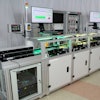According to a recent MAPI study, nearly half of all CEOs and presidents in the manufacturing industry say baby boomer retirements hurt their business. With a presumed 10,000 baby boomers retiring daily, the financial and operations repercussions of this turnover are extreme.
While employee retirement may not initially seem like a major problem, it’s a significant drain on company knowledge, expertise and efficiency. What’s worse, in an age where almost everything is digitized, it’s a problem manufacturers can easily prevent with innovative solutions like a cloud-based computerized maintenance management system (CMMS). However, up to 40 percent of manufacturers still manage their assets and facilities manually or via homegrown systems and face roadblocks when it comes to changing the status quo. This means that when employees retire, many are taking crucial business knowledge with them that previously served as the backbone of the company’s operations.
What An Aging Generation of Workers Will Leave Behind
In 2022, almost a third of those between the ages of 65-74 will still be working. Whether due to modern medicine, financial incentives, or other reasons, this generation of employees continues to work into old age, accumulating anywhere between from 30 to 50 years of experience. As such, when baby boomers retire, they take massive amounts of critical company knowledge with them. The consequences of employee turnover are particularly harsh within the manufacturing industry, where baby boomers make up a majority of traditional maintenance and facilities management jobs today.
Adding to this dilemma, there simply are not enough new skilled employees to replace retirees. For example, there are major increases to construction job openings this year, but 87 percent of construction companies are dealing with a shortage of skilled laborers to fill these positions. Across many industries, the need to supplement outgoing baby boomers with fresh workers is not being met.
How CMMS Can Build the Mobile Workforce of the Future
In light of staffing challenges, manufacturers still using manual management systems expose themselves to significant knowledge loss when employees retire. Moving forward, manufacturers can safeguard themselves against the repercussions of maintenance and manufacturing professional retirements with CMMS in two ways. First, modern CMMS securely retains asset and maintenance data otherwise lost to turnover in a centralized, digitally-integrated hub. For example, specific preventive maintenance tasks, such as oil changes or material contamination checks, can be accessible to all appropriate users. This is true even after long-time employees retire. And second, CMMS can serve to satisfy a predictive problem-solving strategy that helps manufacturing businesses run more efficiently by assisting in identifying and preventing potential failure points.
In particular, modern CMMS has the mobile capabilities necessary to bring businesses into the 21st century. While generations past did not use devices like smartphones and tablets in the workplace, younger employees have come to expect and rely on a mobile-first work environment. The global mobile workforce reached an estimated 1.3 billion, with a big push coming from millennial employees, who are using mobile to complete tasks like taking notes, sharing documents, and capturing and uploading images. Among workers age 18-34, over a quarter of work is done on smartphones or tablets.For this group in particular, apps that maintain a “finger-friendly” design - that is, one that incorporates pinch-and-zoom, swipe and touch gestures, will go the furthest with mobile-savvy millennials.
As turnover continues, manufacturers must not only find ways to retain critical data at risk to loss, but they must also evolve their structures to meet the needs of the new generation of employees replacing those leaving. To support an increasingly mobile-dependendent workforce and preserve key company information, companies should implement internal technologies with a wider network of native mobile applications. With the benefits listed below, modern, cloud-based CMMS solutions can improve a company’s entire maintenance operations, making it easier for teams to do their jobs well:
1. Day-to-day Management Needs
From an operational standpoint, CMMS saves manufacturers time and money during periods of employee turnover. While it’s easy to lose reports stored by hand, advanced CMMS workflows can automatically distribute particular reports to key personnel for easy management of the maintenance function.
This kind of automation generates efficiencies within routine maintenance activities. And when made accessible on mobile, employees can organize and leverage concise notes and steps to complete work orders, see up-to-date parts information and assets with greater accuracy. With a simple search via QR codes, employees have a wealth of data at their fingertips.
Additionally, when CMMS is integrated with mobile, employees can use their smartphones’ photo features to upload images for assets, work orders and parts. As with QR codes, this association between core CMMS functionality and its real-world image makes it easier for new employees to independently understand and replicate the jobs of their predecessors. When experienced workers enter concise notes and steps into CMMS, their individual knowledge of technical issues or machinery particularities becomes company knowledge.
2. Geo-Tagging Capabilities
As mobile should, CMMS with a mobile application allows employees to find critical data and documents on the go -- both on and off site. As companies expand and grow their businesses, it’s important that team members can quickly find and rely on information to do their jobs better.
When available, today’s geo-tagging capabilities allow users to visually map any assets, part or work order by location. For example, employees can log onto a cloud-based mobile app while en route to another location, and check the status of necessary repairs or existing preventative maintenance taskss at the destination.
Rather than acting without full-knowledge that could result in major financial losses, maintenance professional can access their data and go about their jobs with confidence. The best CMMS should also offer offline editing options, which allow users to access work order data even when not connected to WiFi or cellular. No matter their location, users can capture valuable maintenance data where and when they need it.
3. Seamless Cross-Device Transitions
Mobile devices are certainly growing in importance, but they have yet to completely replace traditional, browser-based management systems. As such, the most effective CMMS options are those that facilitate seamless transitions between devices.
For starters, frictionless CMMS allows employees to use the same login credentials on mobile as they would via browser. Once logged on, sophisticated CMMS will also reflect any changes made on device on other devices in real time. For instance, if an employee updates a work order via mobile while on site, that information will appear in any desktop browser-based experience, which creates necessary continuity across an entire workforce.
Not only should information be shared between devices, but leading CMMS solutions should offer a mobile app designed with the same intuitive interface users expect from a desktop experience. No matter a user’s age or experience level with mobile devices, CMMS should always incorporate the latest design technologies and enhance the user experience, to make it easy to use and make completing tasks more efficient and organized.
Employee turnover — whether generationally or otherwise — is an inevitable roadblock every company will encounter. A robust CMMS is a smart way to avoid these pains within maintenance operations, and a truly useful program’s mobile offerings will also help new employees thrive. For today’s most innovative manufacturers, this must include mobile solutions that make it easier to access and leverage core CMMS functionalities.






















